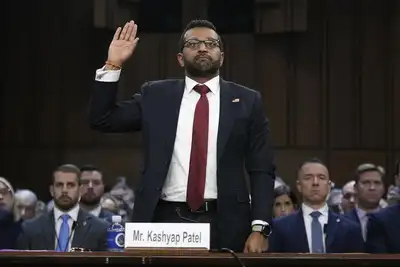Kash Patel : Appointed as FBI Director
Kash Patel, born in New York to Gujarati Indian parents, honored his roots by chanting “Jai Shri Krishna” and touching his parents’ feet during his Senate confirmation hearing for FBI Director in 2025. A close Trump ally, he challenged the Russia investigation and authored The Plot Against the King, echoing Trump’s views on the Steele dossier. His rapid rise — from public defender to Chief of Staff for the Acting Secretary of Defense — stirred controversy due to his limited military background. Nominated as FBI Director in 2024, Patel’s ties to foreign clients and fierce loyalty to Trump sparked debate. Despite the controversies, he was confirmed by the Senate in 2025. Supporters see him as a patriot fighting the “deep state,” while critics question his conflicts of interest, making him a polarizing figure.
The U.S. Senate is composed of 100 members, with each of the 50 states electing two senators, regardless of population size. Senators serve six-year terms, with about one-third of the Senate up for election every two years. The Vice President of the United States serves as the President of the Senate and can cast a tie-breaking vote. The party with at least 51 senators holds the majority, influencing leadership roles, committee assignments, and the legislative agenda. This composition plays a crucial role in confirming high-level appointments, as a simple majority is required for approval.
Mains Question GS2
Compare and contrast the appointment process of high-level functionaries in India and the USA, such as ministers, the FBI Director, and similar positions. Discuss the roles played by the executive, legislature, and judiciary in these appointments.
In democratic systems, the appointment of high-level functionaries reflects each country’s constitutional framework and political traditions. A comparative analysis of India and the USA reveals both similarities and distinct differences in the roles played by the executive, legislature, and judiciary.
1. Executive’s Role
-
India:
In India’s parliamentary system, the Prime Minister exercises primary authority in selecting ministers. Although the President formally appoints them, this is done strictly on the Prime Minister’s advice. This centralized process allows the executive to form a cohesive government that is collectively responsible to Parliament. -
USA:
In the United States’ presidential system, the President has the prerogative to nominate high-level functionaries such as the FBI Director and Cabinet secretaries. However, these nominations are subject to a more distributed process where the executive’s choice is only the starting point.
2. Legislature’s Role
-
India:
While ministers in India are accountable to the Parliament through mechanisms like question hours and debates, the legislative body does not play a direct role in the appointment process. The process remains largely an executive function, and the legislature’s oversight is exercised post-appointment through confidence and accountability measures. -
USA:
The Senate plays a critical role in the appointment process. After the President’s nomination, the Senate undertakes extensive scrutiny—holding hearings, debates, and ultimately voting to confirm or reject nominees. This “advice and consent” mechanism is a key check on the President’s power, ensuring that appointees meet the required standards of competence and integrity.
3. Judiciary’s Role
-
India:
The judiciary in India typically stays clear of intervening in political appointments unless a clear constitutional or legal irregularity is alleged. Its role is generally reactive—addressing petitions or challenges concerning the legality of appointments rather than actively overseeing the selection process. -
USA:
Similarly, in the USA, the judiciary’s role is limited to judicial review. While it does not partake in the appointment process, it can be called upon to resolve disputes if appointments are challenged on constitutional grounds. This limited intervention reinforces the separation of powers, with the judiciary acting as a safeguard against potential overreach.
4. Comparative Insights
-
Centralization vs. Checks and Balances:
India’s system centralizes appointment decisions within the executive, thereby promoting political unity and collective responsibility. In contrast, the US system employs a robust system of checks and balances, with the Senate serving as a counterweight to the President’s choices, ensuring broader consensus and accountability. -
Political Accountability:
Ministers in India, though selected solely by the executive, are collectively accountable to the legislature, which can force a government resignation if confidence is lost. In the USA, appointees such as the FBI Director, once confirmed, operate with a degree of independence from the legislative branch, though they remain subject to oversight through congressional hearings and investigations.
Conclusion
The appointment process in India and the USA reflects each nation’s constitutional ethos. India’s model emphasizes executive dominance with legislative accountability post-appointment, while the US model integrates executive nominations with active legislative oversight. In both systems, the judiciary’s role remains peripheral yet crucial in upholding constitutional propriety, thereby ensuring that the process of appointing high-level functionaries aligns with democratic norms and the rule of law.




